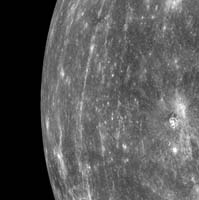|
COMETS EARTH JUPITER KUIPER BELT MARS MERCURY METEORITES NEPTUNE OORT CLOUD PLUTO SATURN SOLAR SYSTEM SPACE SUN URANUS VENUS ORDER PRINTS
PHOTO CATEGORIES SCIENCEVIEWS AMERICAN INDIAN AMPHIBIANS BIRDS BUGS FINE ART FOSSILS THE ISLANDS HISTORICAL PHOTOS MAMMALS OTHER PARKS PLANTS RELIGIOUS REPTILES SCIENCEVIEWS PRINTS
|
Related Documents
Download Options
Date acquired: March 29, 2011 Of Interest: MESSENGER acquired this image of Mercury's horizon as the spacecraft was moving northward along the first orbit during which MDIS was turned on. Bright rays from Hokusai can be seen running north to south in the image. MDIS frequently acquired images that contained Mercury's horizon during the mission's three Mercury flybys. However, now that MESSENGER is in orbit about Mercury, views of Mercury's horizon in the images will be much less common. The field of view for MDIS will generally be filled with Mercury's surface as the instrument maps out the planet's geology in high resolution, stereo, and color. Occasionally, in order to obtain images of a certain portion of Mercury's surface, the horizon will also be visible. On March 17, 2011 (March 18, 2011, UTC), MESSENGER became the first spacecraft to orbit the planet Mercury. The mission is currently in its commissioning phase, during which spacecraft and instrument performance are verified through a series of specially designed checkout activities. In the course of the one-year primary mission, the spacecraft's seven scientific instruments and radio science investigation will unravel the history and evolution of the Solar System's innermost planet. Credit: NASA/Johns Hopkins University Applied Physics Laboratory/Carnegie Institution of Washington |
